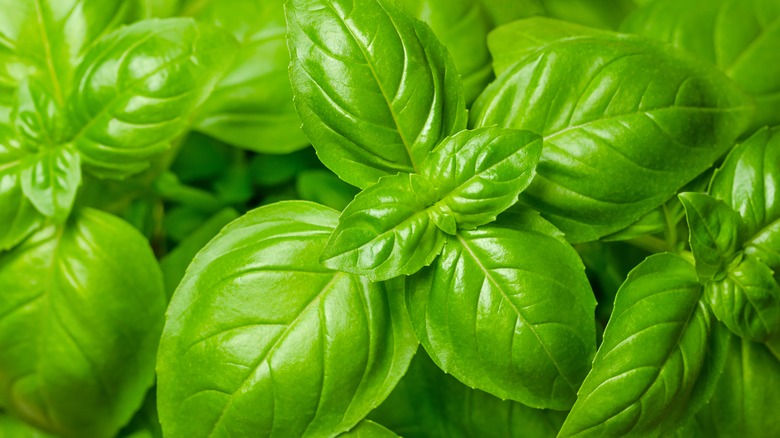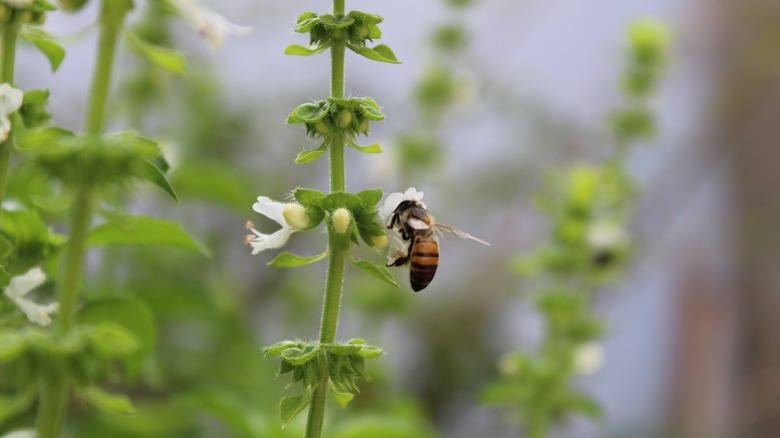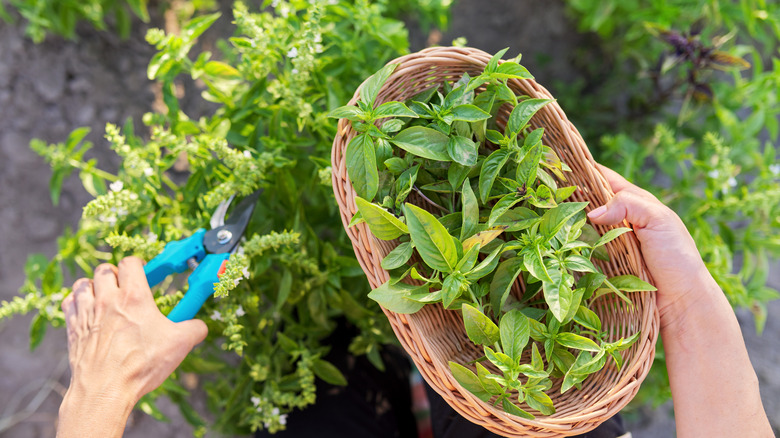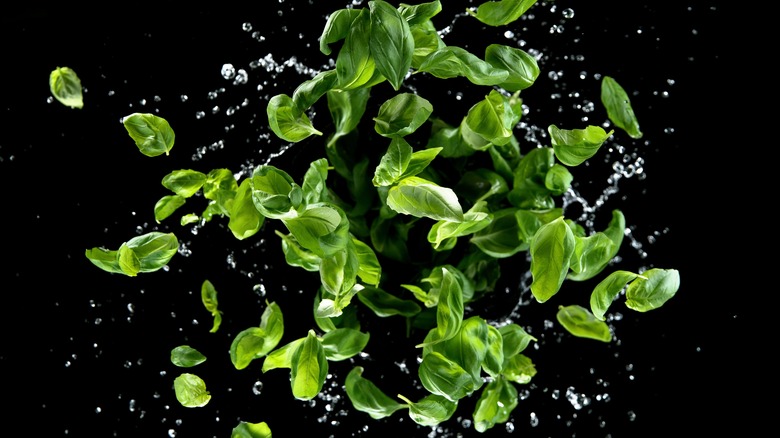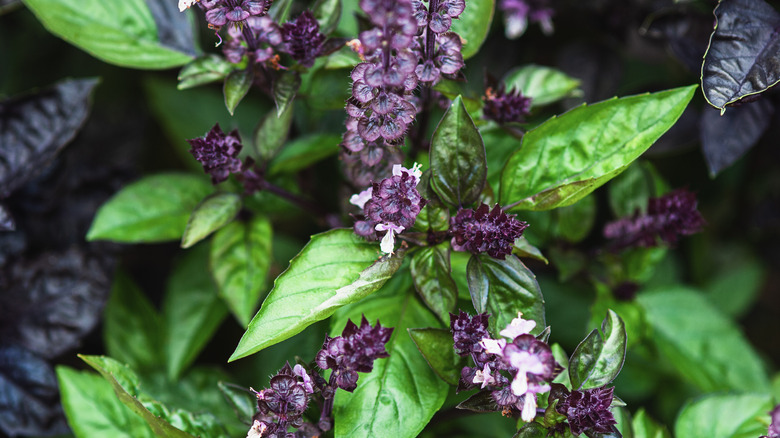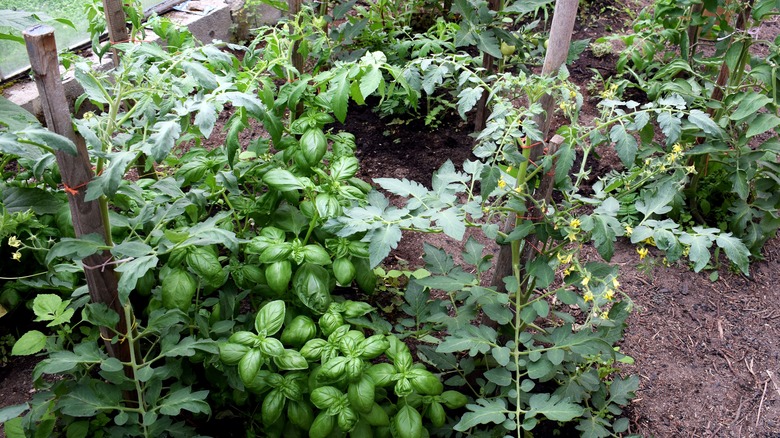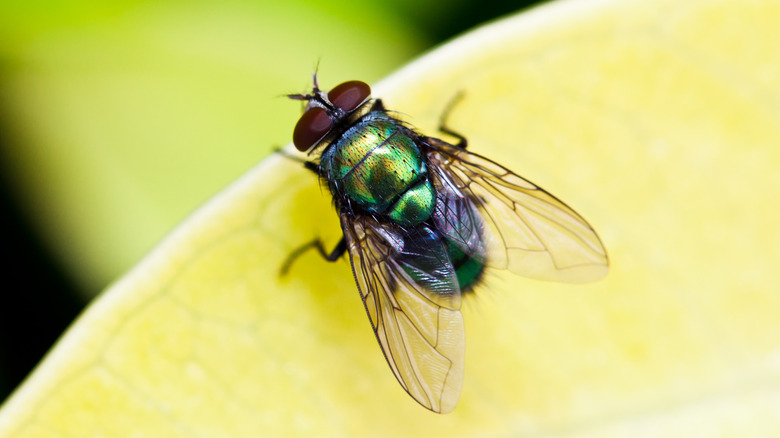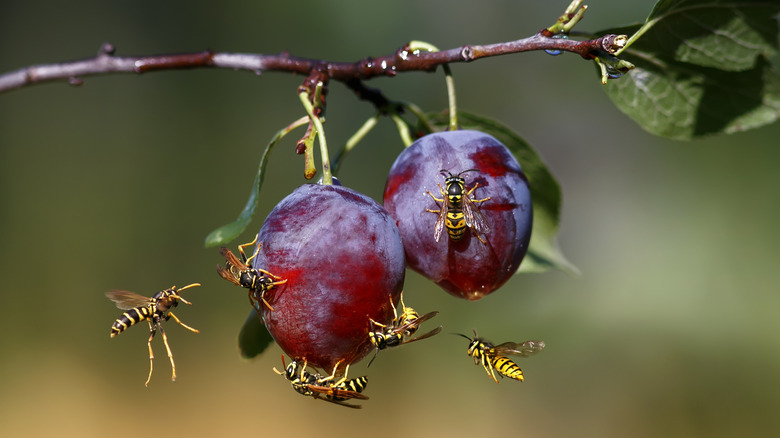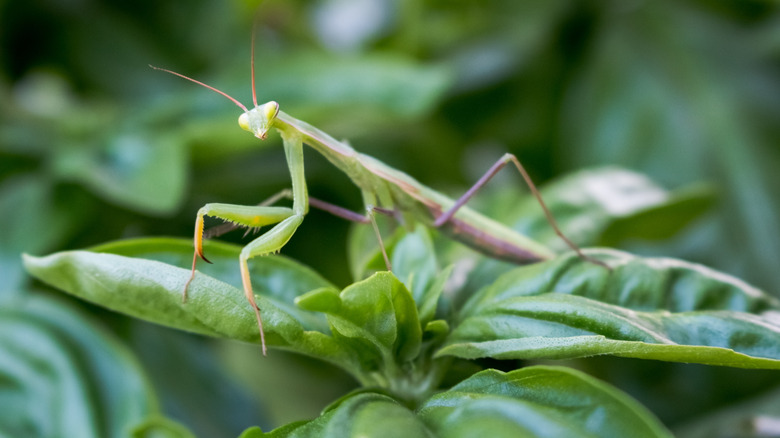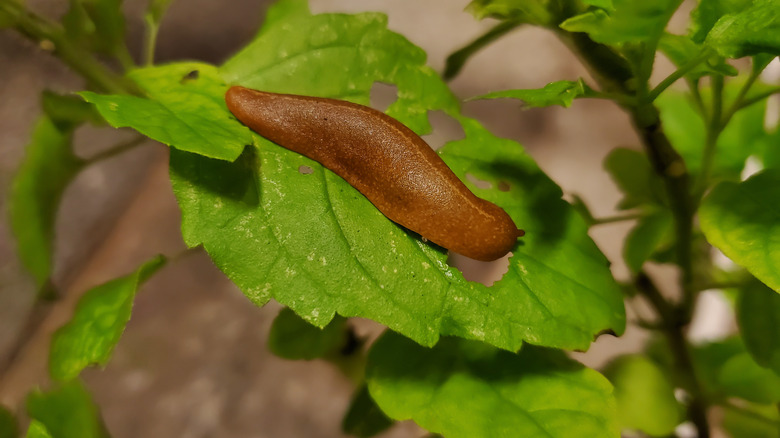9 Reasons You'll Want To Add Basil To Your Garden ASAP
If you're plotting your backyard garden, consider adding basil to the list. Introducing a few plants or a whole row of this lush, green herb will have your garden and home brimming with possibility. Not only does this plant have medicinal properties and taste great in the kitchen, but it will also benefit the health of your garden, helping manage pests and attracting helpful insects.
As part of the mint family, basil has an earthy flavor and a refreshing aroma that can call to certain species and work as a deterrent for others. However, the taste and appearance can vary slightly based on the type of plant. Common varieties include sweet basil, which is most commonly used for cooking, lemon basil, with a citrusy flavor, and Thai basil which has a slightly more licorice taste. Purple basil is also frequently available at nurseries and farmer's markets.
Basil thrives in warm weather, meaning as long as the temperature stays above approximately 50 degrees, these plants shouldn't require too much care or expensive growing fertilizers. You only need to water your basil when the soil becomes dry or the leaves begin to wilt. The benefits of growing basil are endless and you don't need a complex background in gardening to get this plant to thrive. Check out these 9 reasons to add basil to your garden as soon as possible.
Basil is good for the bees
An important reason to plant this household herb in your garden is that in addition to being a versatile element in the kitchen, it also benefits the bees. Bees and other pollinating insects are responsible for the growth of several plants that humans rely on as food sources, including apples, avocados, sugar cane, strawberries, and many more. However, the number of pollinators has been on the decline over the past years, which can be blamed on parasites, pesticides, and loss of natural habitat. Providing this particular plant for bees to feast on can help them fight off dangerous parasites that are contributing to their decline.
Some research has found that certain varieties of basil, such as African Blue Basil, can greatly benefit pollinators even more than sweet basil. This variety will grow into a gorgeous, full plant that produces dark purplish-blue leaves and flowers that will be alive with pollinators of all kinds. The nectar and pollen are very attractive and will provide a nourishing habitat for bees in your garden. Growing basil for bees is a slightly different process compared to harvesting it for the kitchen. The bees will be attracted to the flowers, which contain the pollen, and this means the basil will need warm temperatures that signal the plant to produce seeds. Most gardeners tend to prune their basil plants regularly to avoid flowering, as this can slow down the growth of new leaves. To help the bees, plant a few extra plants that are intended to flower and avoid pruning them.
It's easy to propagate
Propagating basil is simple enough with just a pair of scissors and any small container of water. The best time to take cuttings from your basil is after your plant has grown to about 5-6 inches and is steadily producing new leaves. Using a pair of sharp scissors or garden shears, cut a section of the stem that is 2-3 inches long. The best place to cut is right above two new leaves, which you will pull off. Place the stems in about an inch of clean, filtered water in a container that won't leak. Clear containers work best, as the sunlight can reach the stems and roots as they grow. A few spindly roots will appear and grow in the water in just a few days. Once a solid group of roots has grown, you can transplant the new plant into very damp soil either in the ground or a pot, and enjoy a bounty of basil.
Basil is easy to dry and preserve
If your backyard garden is not only a hobby but a way to feed your family or cut back on expensive grocery bills, basil is highly recommended. Fresh basil might not grow year-round in your climate, but the herb is extremely simple to preserve, which means you can enjoy the slightly minty, earthy flavor no matter the weather.
Sweet basil, lemon basil, and cinnamon basil are excellent options if you're planning to consume what you grow in your garden. These varieties have the best flavor for cooking and just a few plants can produce a large amount of basil in a short period of time. The trick to preserving your basil is to harvest it early in the morning when the leaves are juicy. Pinch the larger leaves off where they meet the stem and this will encourage more leaves to grow and won't damage the plant. Pay attention to the stems of your plants. If they become hard and appear woody, then the basil could have a bitter taste and may be past its prime.
After harvesting basil, you can dry the leaves for 3-4 days or in the oven, before crumbling into a fine texture. There are many options for freezing, either by adding the whole leaves to an airtight bag, or by freezing basil in cubes of olive oil to use in cooking.
Certain varieties of basil have beautiful flowers
Basil might not be the first plant to come to mind when plotting your flower garden, but it's not one you want to overlook. Spotting basil in potted flower arrangements has become a more popular option, especially outside of restaurants where a few sprigs might come in handy. If pruned properly, basil can become a vibrant bush that is not only a beautiful shade of green but also fills out a pot. However, basil is an excellent option for your garden because it produces bundles of delicate white and purple flowers that will look stunning in your vegetable garden, around your patio, or scattered throughout your flower garden.
In fact, planting basil around your yard as an ornamental plant will yield wonderful results as well. For a more decorative variety of basil, consider planting African Blue basil. The leaves alone are a deep purple and green color and you can expect long stems of purple flowers to shoot up as the weather reaches its peak heat. Along with bees, these flowers are also loved by butterflies. Lemon basil plants are more likely to grow small white flowers that not only look nice in your garden but are an excellent garnish in your iced tea or cocktail. Sweet basil, which is the most commonly found basil, often grows small white flowers that appear when the temperature rises. To ensure that your basil plant produces flowers in your garden, avoid pruning the leaves and stems.
Basil will help your tomatoes thrive
What's better than a fresh salad with basil and ripe tomatoes? Nothing says fresh like this combination. This pairing is a no-brainer because growing basil near your tomato plants can improve the growth of the fruit and even possibly improve the flavor. Numerous studies have shown that planting basil next to or in between your tomato plants can greatly benefit their overall health. In one study, research revealed that after five months, certain properties known as allelopathics in basil had similar effects as fertilizer on the tomato plants. The fruit grew larger with the addition of basil and the germination time was faster. Finally, the roots seemed to be stronger and larger when basil was present.
This trick is simple to implement in your garden because basil and tomatoes require the same growing conditions to thrive. Both types of plants need warm temperatures, above 50 and up to 80 degrees. They also thrive in full sun, do not tolerate shade very well, and do best with moist but well-draining soil that's regularly watered. It's recommended that basil plants be grown in a row next to tomato plants. Although you can scatter groups of basil in between the tomatoes, be sure to allow for plenty of space. Certain varieties of tomatoes can grow into large plants that might overshadow basil and block out the sunlight that's needed to thrive. It's also believed that basil can deter certain insects that can be a nuisance to healthy tomato plants.
Basil can repel flies in your garden and house
You might not suspect your garden as a source that's attracting flies, but they can be drawn to fertilizers, compost piles, and decaying matter. The last thing you want while enjoying your beautiful garden is a fly problem. One way to avoid this is to plant basil in your garden, and even in pots around your outdoor spaces and inside. Basil has an earthy, distinct aroma, which is noticeable when cooking, and that scent is infuriating to pesky flies and effectively keeps them at bay. Basil plants naturally contain citronellol, which is known for its insect-repelling properties. Simply planting basil in your garden can help keep flies at bay, especially in areas where you have crops or compost.
Although the presence of basil can deter flies, the best way to take advantage of this plant is to increase the scent. You might try breaking off a few basil leaves to put in your pocket while in your garden or try rubbing them between your fingers and over your skin. If you're dealing with a big fly problem, you can use fresh basil leaves to create a natural insect repellent that can be used outside and in your home. Deterring flies and fruit flies is a common use of basil essential oils. Finally, you can crush the leaves and place them around your garbage cans or in areas where flies tend to congregate. The scent might not last for long, but it's a natural way to scare off buzzing flies.
Basil can repel wasps
Basil is an herb that is known for its culinary uses in many different types of cuisine around the world. However, what many gardeners don't know is that basil can also be an excellent wasp repellent. This is just another one of the many reasons why you'll want to add basil to your garden ASAP.
Basil contains a component called eugenol, which is responsible for basil's spicy, strong fragrance. The eugenol oil is also responsible for repelling wasps. The presence of eugenol oil has been known to keep wasps at bay and sprays that contain the ingredient have also been used to treat wasp nests. When wasps come into contact with this oil, it confuses their senses, making it difficult for them to locate their nest or prey. In recent years, more prominent forms of eugenol oil have been used for pest control in homes and could be the answer for more natural insect repellents that don't contain harsh and dangerous chemicals. Planting basil in your garden and around the foundation of your home can help discourage wasps from setting up camp in areas where they could become a nuisance.
Basil can attract bugs that eat pests
Basil will also benefit your garden because it will attract certain species of bugs that target unwanted pests that can harm your plants. This is another step in the companion planting process. This technique has been used for centuries and involves pairing plants to maximize their potential. This little trick is hardly any extra work, because you're bound to use up the basil as it grows.
Certain varieties of basil will attract an insect called Praying Mantis, especially African Blue Basil. Praying Mantises are not necessarily drawn to the basil leaves, as they are carnivores. They are more likely attracted to the bees and other pollinators that feast on the flowers and pollen. However, the Praying Mantis will flock to your garden if it will provide a hearty food supply. A nicely balanced garden will provide a mini ecosystem where the basil attracts beetles, bugs, and Praying Mantises. However, the predator will then eat other pests and keep your garden thriving.
For a garden that will support this trick, plant a few African Blue Basil plants throughout your plot. African Blue Basil will produce a bounty of blossoms; however, sweet basil and lemon basil will eventually go to seed and also attract these critters. If you're dedicated to a balanced garden, consider allowing a few basil plants to go to seed early in the season to satisfy the insects.
Basil can distract slugs and snails from destroying your garden crops
Finally, this versatile herb turns out to have another equally essential role, which is to distract slugs and snails from destroying other plants in your garden. It has been well-documented that slugs and snails, common pests in gardens, have a fondness for basil. This attraction can be used to your advantage to preserve other vegetables in the garden. Especially when slugs are known for chomping their way through just about any leaves on any plant. They're not picky eaters and your garden has plenty of dark, damp places to hide, providing the perfect environment for them to thrive and feast.
These pesky slugs are particularly drawn to basil plants. They love to chomp their way through many leaves, which can put stress on the plants and cause growth to slow down, or eventually kill the plants. Planting a few basil plants in areas that stay extra damp, can help keep your other vegetables intact. Certain slugs have a weakness for the herb and, when present, will choose to feast on the basil instead of the other vegetables. This means that planting basil adjacent to other crops that are susceptible to slug damage, such as tomatoes, strawberries, and more can greatly improve the chance for your garden to thrive.
